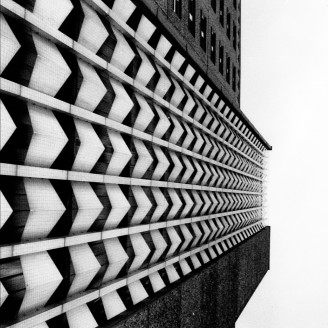Dutch producer Boris Bunnik has been working with a handful of pseudonyms since the late ’00s, none for more than a couple releases with the exception of his core moniker, Conforce. Bunnik produces vertically slanted dub-wise techno as Conforce and it’s from here all his other mutations seem to stem. The end of last year saw Bunnik’s efforts under the Conforce name reach a zenith of sorts with Escapism, the Dane’s most accomplished work to date and a prime document of modern, cloudy-eyed dub. Silent Harbour, the eponymous full-length debut of Bunnik’s newest pseudonym, and his first for Danish techno label, Echocord, follows less than a year later with ten new cuts of conceptually-sound material and sees Bunnik exchanging the metallic, airy canopies and heaving 4/4 of Escapism with more fractured and darkened, subterranean territories.
On Silent Harbour Bunnik’s stated focus lies in insular and subconscious realms as well as sub-aquatic, perhaps metaphysical, free-fall. The Dane describes the album as a kind of internal journey — “an imaginary deep mental abstract excursion.” It’s the sort of language that might throw up some red flags, veering awfully close to the dreaded P-word, but there’s really no better description for Silent Harbour, and upon hearing the album it becomes clear Bunnik’s ambitions are atmospheric rather than academic.
Silent Harbour doesn’t eschew Bunnik’s techno foundations, but rather submerges them, letting them writhe and scatter in abstracted, asymmetrical variations, creating an immersive, womb-like universe that’s lullingly rhythmic and rich with throbbing, malevolent sub-bass, chittering percussive textures, and thick underwater machine-dub aesthetics. The album is only pertinently ambient in small stretches like on “Scintillans In The Port” and “Dock Operations,” which let reverberating, rhythmless percussion settle around hissing, serpentine machine drones, but even on 130 BPM cuts like “Geometry” or “Metaphysical Storm,” the rhythms never feel overt, only suggestive. Percussion never really steps out beyond being an inverted textural driver. Silent Harbour focuses on designing layered, mechanical soundscapes, filling each track with beautifully tactile surfaces, surrounding them with thick shrouds of darkened, ghostly fog, and letting them languish in shifting ocean floor currents.
“Descending Radius Curve” encloses its suffocated-to-nothing 4/4 and plunky piano sample with layers of mournful vocals like the gathering voices of silhouetted figures on the other side of a darkened canvas screen. “Voices From The Deep” is an oppressive mosaic, bubbling with crackling textures and a flattened boiler room drone while a staggering sub-bass foundation cradles it back and forth. The most impressive track on Silent Harbour is “Saltwater Intrusion” a ten-minute piece that perfectly exemplifies the album’s sonic aspirations. It centers around a glut of howling drones coated with digital clicks and watery plops before a gestating rhythm sidles in, its suckling snare sound lapping beautifully in wound-up temporal variations across the song’s stereofield while more machine textures dive down through like dashes of paint through water. It’s massive, subtly and exponentially arranged, and an aural feast.
Of course, subverting techno structures in favor of ambiance and inversion is hardly a novel concept in 2012. Demdike Stare has been producing hellish dub and drone with bits of techno propulsion sprinkled in since 2009 and Actress’ most recent effort attempted to rewrite the tech rulebook using ambient music as a foil. But Silent Harbour shares little of Demdike Stare’s organic, sample-based mysticism (except for “Descending Radius Curve”) or Actress’ bookish experimentalism. The easiest comparisons to draw are perhaps Loscil’s Submers, which was also preoccupied with exploring underwater environments (albeit in a Gas-esque mold), and the lonesome handdrum tirade on “Cascade” even brings Shackleton’s Music For The Quiet Hour to mind. But Silent Harbour distinguishes itself by finding a constant and precise balance between the absolutes, using understated percussion and a spherical arrangement style that’s never not in fluctuation (not to mention Bunnik remains firmly planted in more digitized realms). The results often feel tangentially related to dance music. “Aquatic Movements,” for instance, sounds like ceremonial psych dubbers Sun Araw if they listened to more Deepchord.
It’s hard not to be surprised by the level of quality and vast amount of detail at work on Silent Harbour. It feels unprecedented to a certain extent. Escapism was excellent and it showed Bunnik was one of the most qualified techno producers in the field, but Silent Harbour is a curveball that separates him altogether. The Dane’s grasp on his conceptual conceits are surpassingly adept and there’s enough life here to found a whole new direction. If this is the only work Bunnik does with the Silent Harbour name, there is the comfort that he knocked it out of the park in one go.

